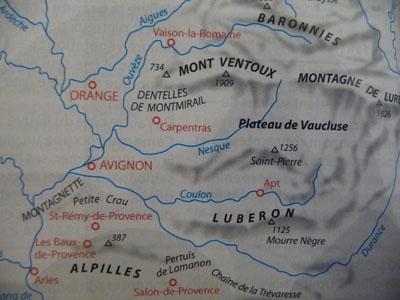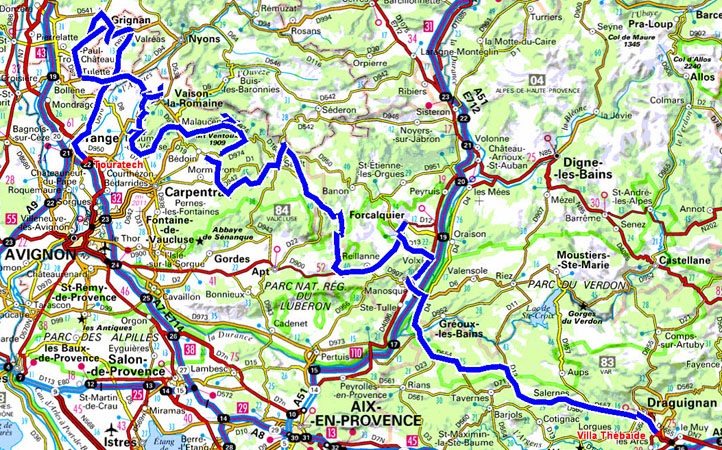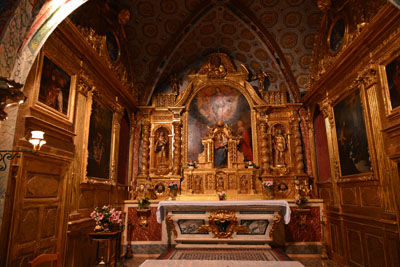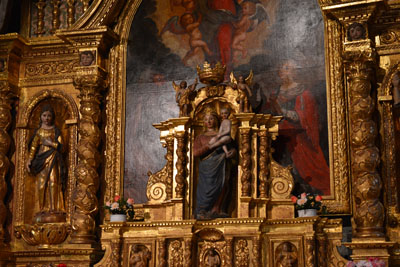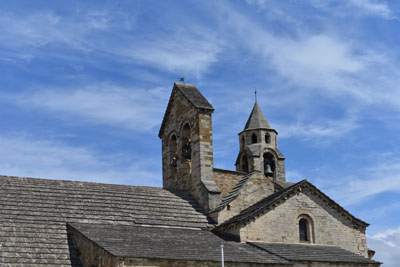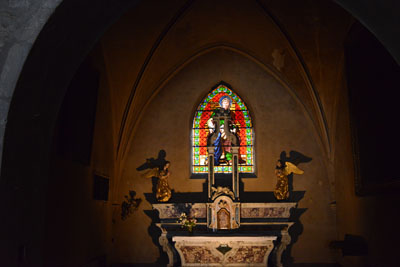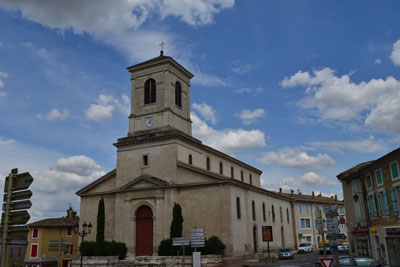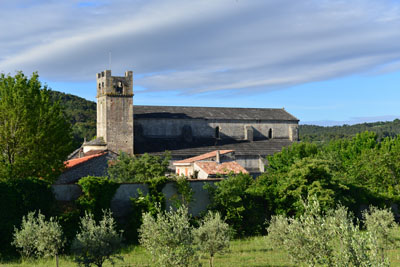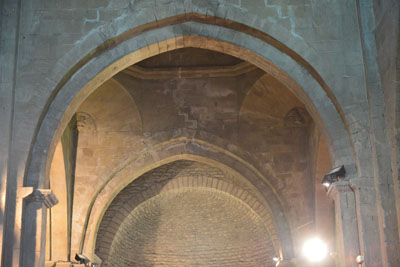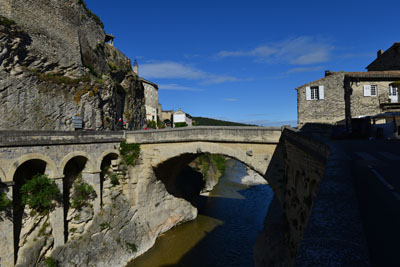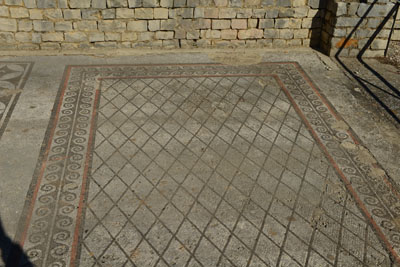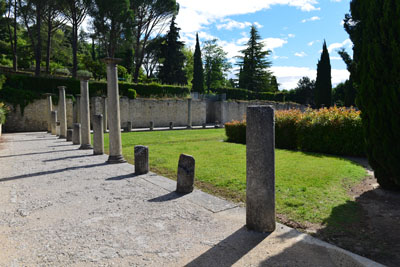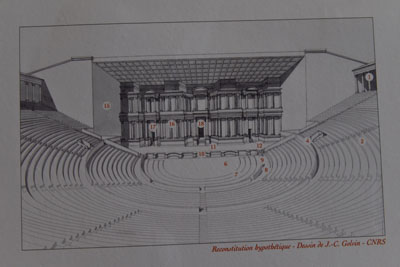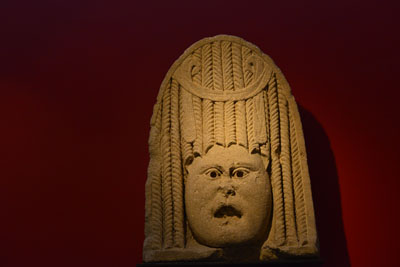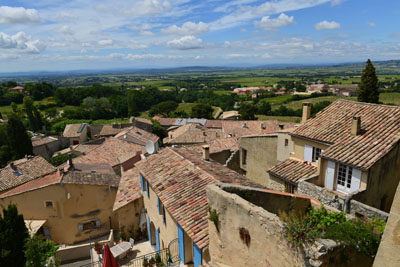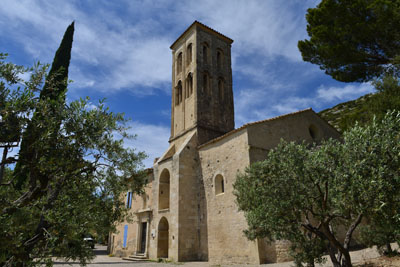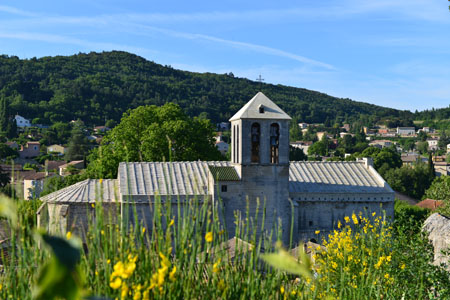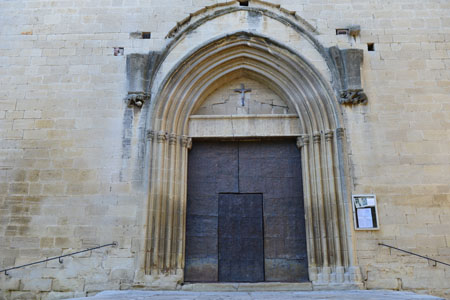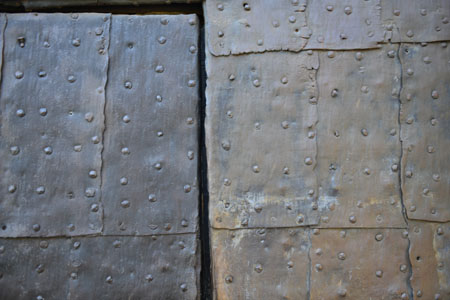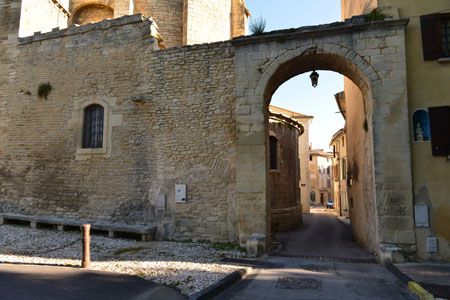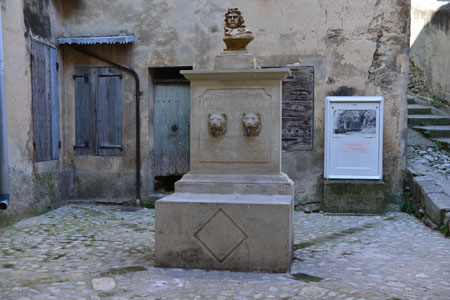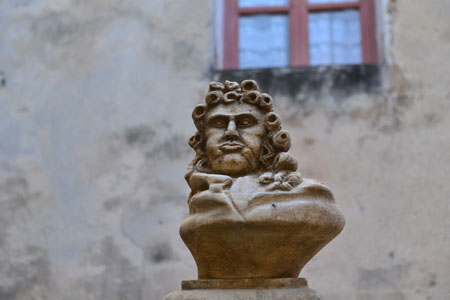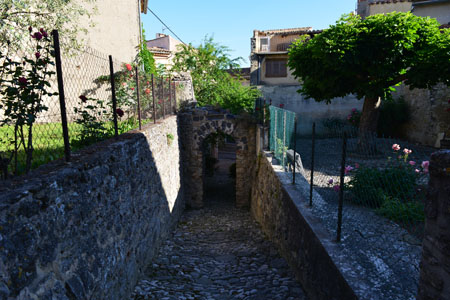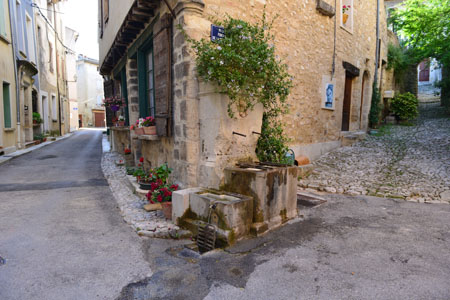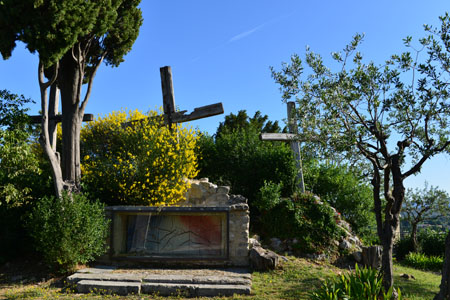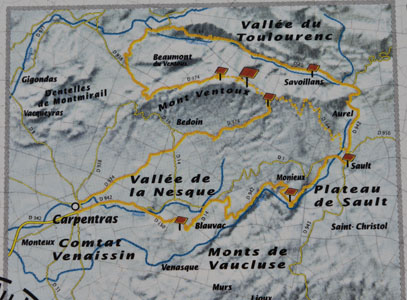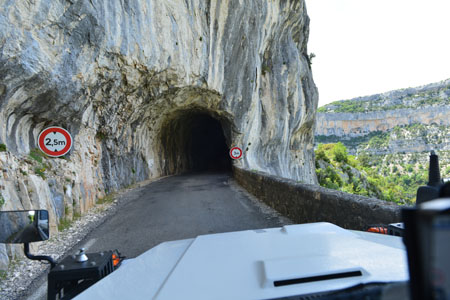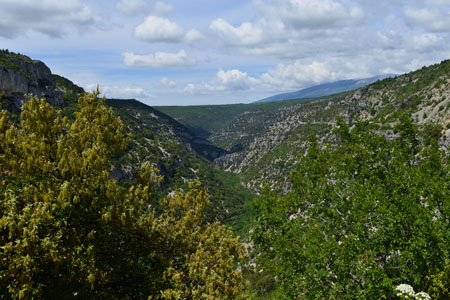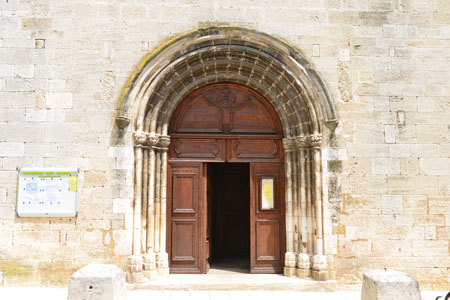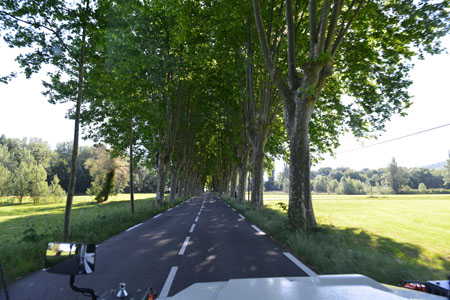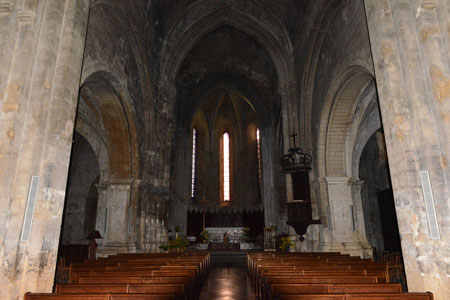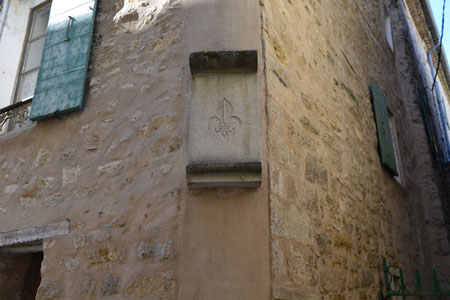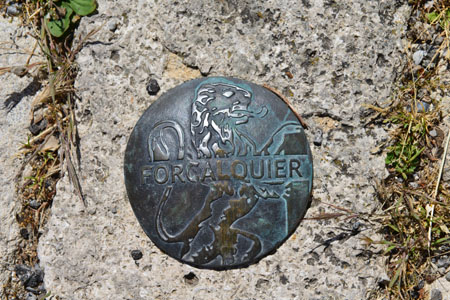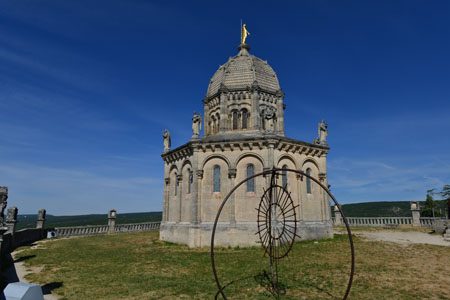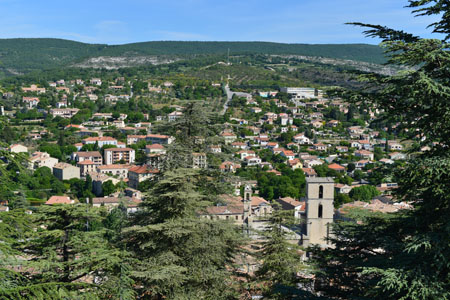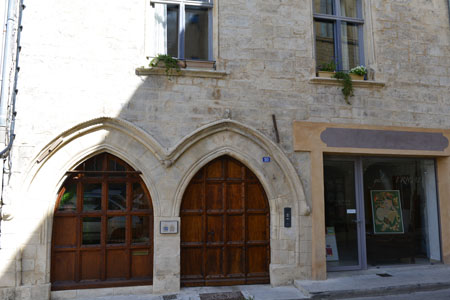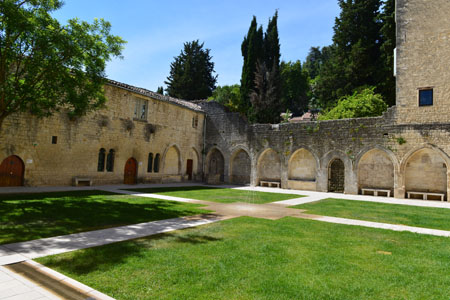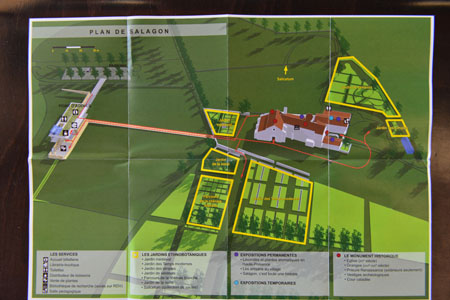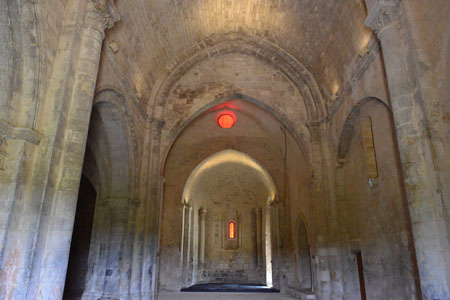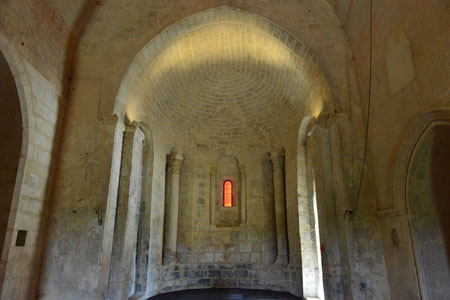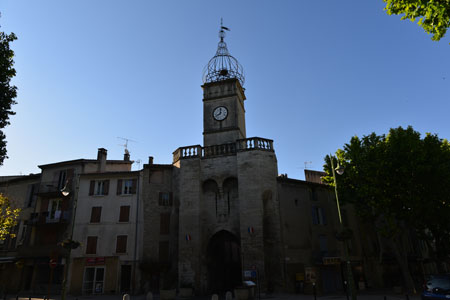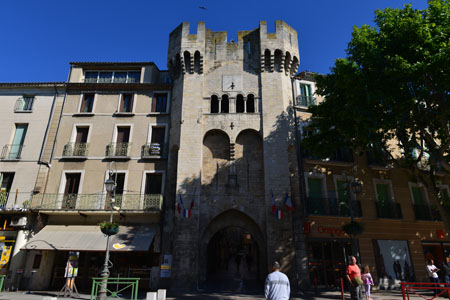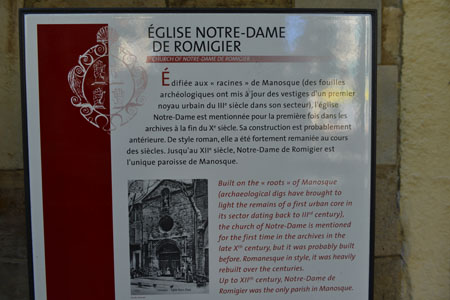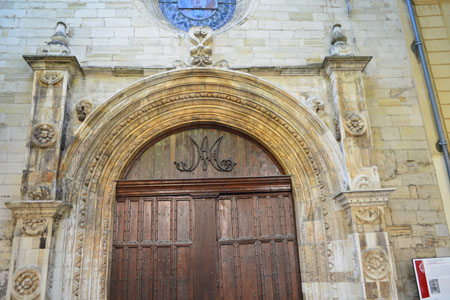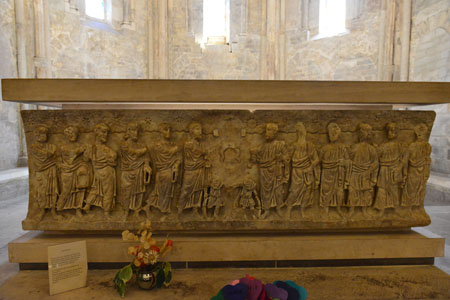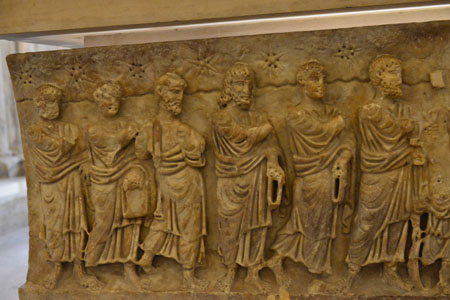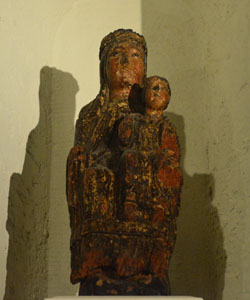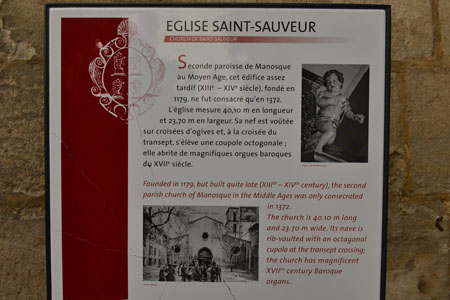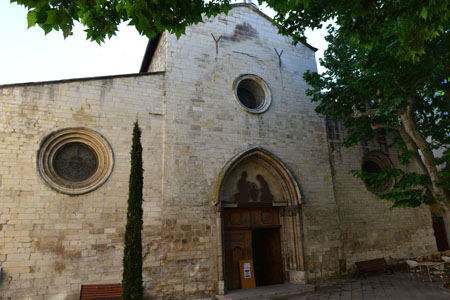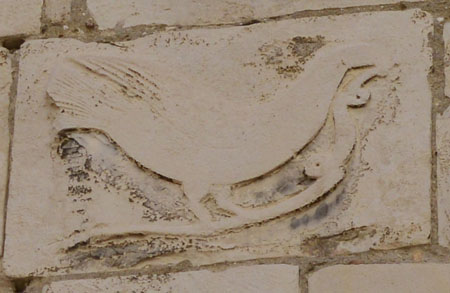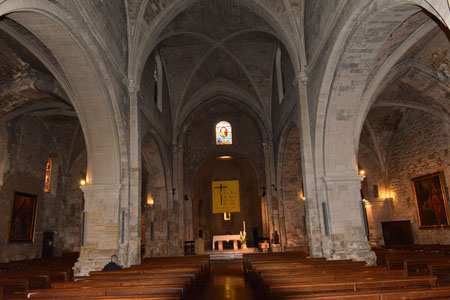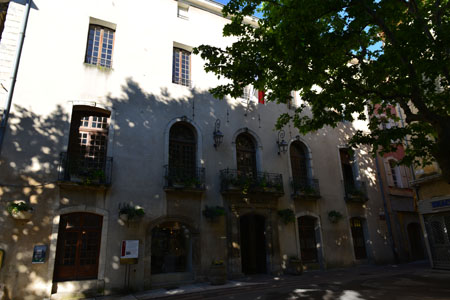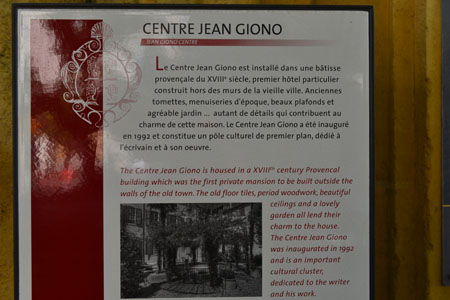On Monday, May 26 I left the car park
within the compound of the Touratech
company where Yvon Bodelot puts at the
disposal of customers a very
fast Wi-Fi connection which enabled me to
publish the update of my website.
The target of the day was to traverse
the tourist road of the Enclave of the
Popes with the highlight of Valréas.
Notre-Dame des Vignes
On the way I made a detour to Visan
to visit the N.D.-des- Vines
vault brood in a small valley close to
a fir plantation. When I got out from
my truck a
sister accommodated me with open arm
and the welcome wished me. She was my
guide to discover this vault dating
from the 13th century to shelter a
Virgin with the infant out of
polychrome wooden venerated by the
popular faith in view of spiritual
demonstrations. The choir has one of
the most beautiful set out of gilded
wood of the South-east of France
having required 70 years of work at
the 17 & 18th centuries.
Valréas
Valréas is the most flourishing city
within the enclave of the popes. Alas in
this Monday of the last week of May
all was closed, churches,
towers. I sauntered in streets
without life nor tourist. The southern
gate of the church
Our-Lady-of-Nazareth is a good example
of the Roman architecture in
Provence. The tower of Tivoli is the
last vestige of the ramparts of the
city.
Richerenches
Richerenches is an old Commandery of
Templars built on a rectangular level
whose four-angle towers remain.
There still the schedules of the
tourist office did not enable me to
visit the closed monuments; I went my
way. On the way I saw the keep vestige
of a passed splendor at Chamaret.
Chamaret
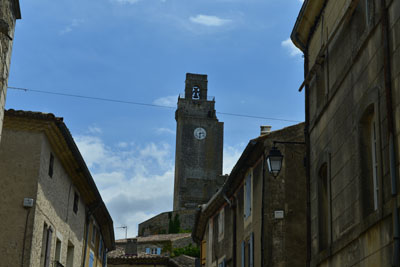 |
| Keep |
Suze-la-Rousse
Finally I stopped at
Suze-la-Rousse, which could be
a heroin, Jenny of the Threepenny opera.
The castle dating from the
Middle Ages was transformed into
palate during 16th & 17th centuries by
the lords of Baux of Orange. I found
a bivouac at Roaix close to
Vaison-the-Roman
Vaison-la-Romaine
Cathedral of N.-D.-de-Nazareth
Vaison it Roman or
Vaison-the-Romanesque it could bear the
two names indifferently, because the
Romanesque is the low city north of bridge
Roman and the Romanesque one is the high
city in the south of the bridge
strengthened with the Middle Ages
against the Muslim invasions.
The cathedral N.-D.-of-Nazareth
was built on Gallo-Roman vestiges at
the 11th century in the Provençal Romanesque
style. The nave is framed by
spans and is overcome by an octagonal
cupola on decorated horns.
Closter
The coupled cloister dates from 12th &
13th centuries and the southern
gallery of the 19th century in which the
capitals are richly decorated.
Roman bridge
2000 years old
Romanesque bridge, is
intact except the parapet rebuilt
after the dramatic rising in 1992.
Gallo-roman vestiges
My
target is not to describe the
Gallo-Roman vestiges would be to be
presumptuous. Tourist guide books do it
better and more learnedly than I could
not do it. Admittedly the vestiges of
Pompeii are more prestigious but those
testify to the history of Gaule and in
these disturbed times, loss of the
reference marks and absence of the
historical values. It was not without
emotions that I traversed them. The
museum has parts resulting from the
excavations testifying to the artistic
wealth to the Gallo-Roman culture.
Séguret
On the way I stopped at the small
village of Séguret to admire the
narrow streets, the pretty fountain,
the belfry and the church,
closed, of the 12th century.
Sablet
On the way I took a picture,
by driving, of the belfry of Sablet.
Laces of Montmirail
I made a detour to make a short walk
of approach of Laces of Montmirail,
Mons mirabilis, which are the
buttresses of the Ventoux Mount. They
extend on tens of kilometers from
Vaison-the-Roman to Beaumes-in-Venice.
Gigondas
I strolled in the streets in Gigondas
famous for its wine for discovering
this charming village whose only
monuments accessible in this period
on the end of May are the old houses
and the frontage of the church!
N.-D.-d'Aubune
A last
detour by a very narrow road to
see the frontage of N.-D-of
Aubune. This Romanesque vault has of
a bell-tower decorated by pilasters.
A footpath offers to the
amateurs of walk a trip to
Romanesque vaults
within the area. I found a
very nice bivouac at the pass of
the Chain.
Malaucène
At early morning I visited Malaucène at
the bottom of Mt Ventoux. I profited from
a nice low angle light illuminant the buildings.
The strengthened church was included in
the wall of the city. It is of Provençal Romanesque
style. It was built in the
14th century on Gallo-Roman vestiges. Alas
the door covered with bronze sheets was
closed. Being next to the church the Soubeyran
gate gives access to the old
city by very narrow streets bearing
evocative names with square in square
murmuring fountains. A way leads to the
martyrdom on a hill dominating the city
and the capped belfry by a wrought iron
bell-tower, like everywhere in Provence.
The sight on the surrounding landscape is
sublime with in background the Mt Ventoux.
Mt Serein & Mt Ventoux
Not without anxiety I launched my truck
on D 974 to the attack of the Mt Ventoux
by pointing out the cycle races of
my youth. Now the amateurs climb it with
ultra sophisticated machines
equipped with last technological
refinements. Of course I carried a
frequency meter to supervise my heart. No
alarm, the pulsations were normal knowing
that the physical-activity of the control
of a vehicle does not require physical effort. On
the other hand I stopped at the Mt Serein,
1420 m of altitude, to make a walk of
about thirty minutes. The frequency meter
recorded an acceleration of the pulsations
higher than that at the sea level for a
similar activity. I noted an acceleration
still higher at the Mt Ventoux, 1911 m
of altitude with a sharp cold & a strong
wind.
Gorges of Nesque
After a frugal lunch on a rest area at the
exit of Bédoin I attacked the Gorges of
Nesque whose Michelin map N° 527
announced some tunnels with a maximum
vertical clearance of 2.5m, but it is true on the
roadside but
in the middle the noted minimal height was
of 3 meters. The landscape is sumptuous
but less arid than in the Gorges of Verdon & Daluis.
Sault
Sault, village of Provence located on a
rocky outcrop, is the old capital of the
county. At its feet cultures, of
wheat, lavender & spices constitute a very
colored patchwork. The church N.-D.-of-the-Tower
is 12th century of Provençal Romanesque
style attested by the porch
and the nave. Alas the museum of the
Gallo-Roman history was closed!
The town is the
base of hikers and cyclists for
the rises. I found a bivouac at the exit
of Aurel on D 542.
Plateau of Albion, The big ears
On Thursday, May 29 I decided to traverse
the small narrow secondary roads in deep
and hard France. Thus I passed on the
Plateau of Albion, where the silos of the
nuclear warheads at the time of the cold
war were buried. The large ears are kept
by a regiment of the foreign legion! Why
not. The Plateau of Albion is a genuine
causse with more than two hundred pits
which absorb rainwater re-appearing at
the Fountain of Vaucluse.
Gorges of Oppedette
I continued my motorized excursion, alas I
flunked the junction to visit the Abbey of
Valsaintes on D 201. The
Gorges of Oppedette or more exactly the Canyon of
Oppedette due to its narrowness is 2.5 km
long dug by Calavon river with a 120 m height
walls. The deserted car park is an
idyllic place of bivouac. Again I missed
the junction for the Priory of Carluc
before Reillanne on a secondary road
without sign post. Not easy when there is
no road sign!
Tree-linen narrow road
Forcalquier
Finally I arrived around 9:30
at Forcalquier,
extremely well indicated on the local
small roads. The Tourist office was opened,
which happiness, and well documented with
a tour to visit the main sights.
Alas, as usual many buildings
were not accessible, the little referred
streets, very often dirtied by the dogs
and stinking the piss of cat, it is
also that France!
Cathedral Notre-Dame-du-Bourget
The cathedral N.-D.-of-Le Bourget was
built at the 12th century with a transept
in Latin cross of Romanesque style but with
additions in the posterior centuries. I
have the privilege by entering to be
accommodated by a concert of organ on one
of the more remarkable instruments in
Provence. I stayed a long moment of
plenitude and unexpected meditation.
Medieval city
Like in all the medieval cities many
squares are decorated with a fountain
dedicated either to a divinity or to a
local character.
The city was a Earl's capital and it
says it…
The hill of the Earls castle
From Castle of the Earls of Forcalquier it
remains nothing; the hill is now occupied
by an octagonal vault, closed. The
St Jean church of the 12th century is in the
state of ruin.
Many private mansions
Many doors of private mansions
preserved their original aspect.
Finally
of strengthened ramparts only the
gate of Cordeliers still remains and for a
few times jet. Further the convent
of Cordeliers, after many historical
vicissitudes, was restored to lodge the
European University of savors and the
scents, a whole program.
Priory of Salagon
The priory of Salagon, at the entrance of
Mane, is clearly indicated, I went there at
the beginning of afternoon. It is restored
and managed by the General Council of the
Alpes de Haute-Provence as well as the
museum and the ethnobotanical gardens(!)
the booklet explains “… plants to tell
men…”. At the beginning the site was a
Gallo-Roman agricultural vast domain, then
was transformed into religious habitat
occupied by various congregations. Finally
it fell into the deprived field at the
French Revolution like national property passing from
hands to hands to fall in the public
domain of the General Council of the
territorial division, which trip!
If the lavender was
told
The small museum tells the story of the
lavender, its culture and extraction
of essential oil. The ancient pictures
are full with charm and testify to the
human conditions. I approached Manosque
which I visited the following day, an
unspecified bivouac accommodated me on the
edges of the EDF channel.
Manosque
The city gates
On Friday after a
rainy night, I left the
edge of the channel as of early dawn to
ensure me to find a parking space close to
the gate of Soubeyran. Well took to
me because the car
park announced by the
Green Guide book was under work; the accessible
part was very reduced but there remained
still an exiguous space. The city was
integrated into the Roman empire thanks to
its proximity to the Domitian Way which
connected Italy to Spain. It was entirely
destroyed into 900 by Muslims. Then the
manosquins returned to rebuild it towards
974 after Guillaume, earl of Arles, had
driven out them from Provence. Of strengthened
enclosure of the Middle Ages and its four
gates they remain about them only two partially
rebuilt at the 14th century.
The city squares
Along the
Grande street connecting the two
gates some decorated shaded
squares with fountains as well some buildings with
beautiful doors surrounded by narrow lanes
structure the medieval city agreeably.
Notre-Dame de Romigier
church
The N.-D.-of-Romigier church located
on the square of the Town Hall is of
Provençal Romanesque style with a
Renaissance porch. It shelters two
remarkable sights. The altar is a Carrere marble sarcophagus
representing the twelve apostles with
hands raised towards God. The Black Virgin
of pre-Romanesque time which according to the
tradition would have been found by a
plowman whose oxen would have
knelt in front of the bush under which she
was buried to protect her from vindication
Muslims. Closed down the church receives
temporary exhibits.
Saint-Saviour church
The
St-Saviour church is set up on the
eponymous square. Of Provençal Romanesque style
it was rebuilt after the raids
Muslims then increased at 16th &
17th centuries. Outside on the left side
street Voland & by raising the eyes it
is possible to see two engravings
stones, one shows a pilgrim with his stick
and the other a hen with a snake. Inside
the organ of 1625 was remade in 1826
by Piantanida, celebrates Lombardi
organ-builder. The left side aisle
shelters a Virgin with the Infant.
Town hall
The town hall dates from the 17th century
with one of the prettiest frontages of the
city.
Centre Jean Giono
The center Jean Giono, writer & child of
the town of parents of Piedmonts origin,
are lodged in the oldest private mansion
out the walls of the city. At the time of
my visit only the ground floor was
accessible.
The Carzou foundation
The Carzou Foundation is
housed in the
vault of the convent of the Presentation
from the 19th century whose walls are
painted with surrealist frescos by Carzou
representing his vision of the apocalypse
at the 20th century. Alas it is opened
for the public only in the afternoon. To
wait I tasted garlic mayonnaise fish
on the square of Town hall. My waiting was not
disappointed. I point out that contrary to
the popular meaning, the apocalypse is not
a catastrophe but the announcement of the
revelation of Jesus Christ. The work of
Carzou started in 1985 was inaugurated in
1991 and
occupied approximately more than
660 m². The allegory of Carzou is based
on the massacres perpetuated by men,
the extermination of the Indians, the
genocides, the holocaust and well of
others like on biblical references, Large
Prostitute (Ap. 117). His trail starts
with a nuclear field flown over by four
supersonic planes, the riders of the
apocalypse (Ap;6,1-8) for finished by the
redemption by the Woman-tree symbol of
hope and revival and finally by a last
allegory with Adam and Eve surmounted by
the triumph of the lamb. In his
presentation Carzou written: “I wanted to
represent the Apocalypse, the climate of
our time… My goal: fear of the year 2000,
a little like the fear of the year Mil…
It is the new world and the Heavenly
Jerusalem… The ships wait for installed
towards a Cythera of dream… Finally it is
the triumph of the lamb and the
terrestrial paradise.”
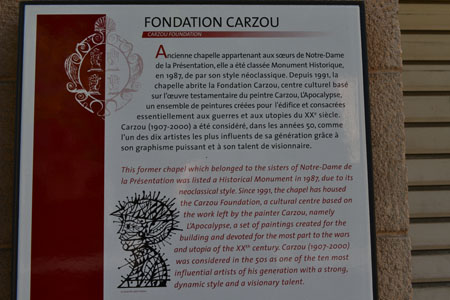 |
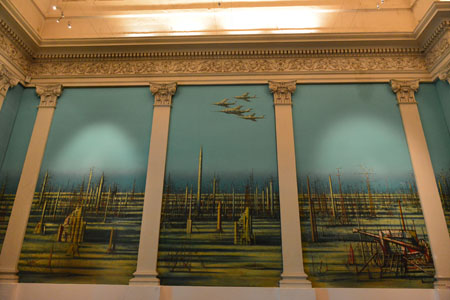 |
|
Nuclear field flown over by
the four riders of the Apocalypse |
 |
 |
| Hitler, Stalin, Pol Pot |
Armenian genocide in 1915 |
 |
 |
| Dictatorship, swastika, hammer & sickle |
French Revolution, the guillotine |
 |
 |
| The Great Prostitute, Babylon... Rome |
The Luxury |
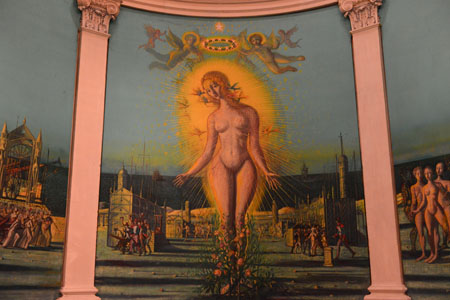 |
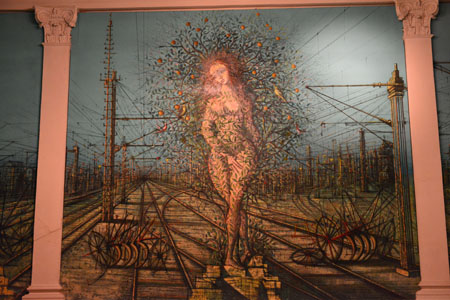 |
| The light haloed Virgin, triumph of purity |
Women-tree symbol of hope and born-again Earth |
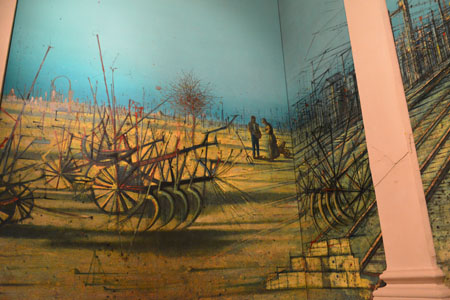 |
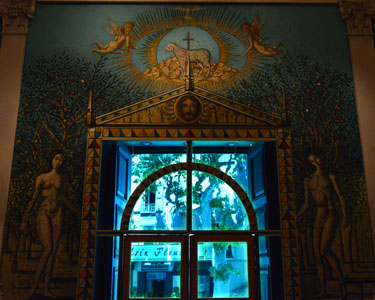 |
| Millet's Angelus |
Hope, Adam & Eve, the triumph of Lamb |
With due respect to the despisers, the
Christian religion is integral
part of our republican culture, which is
with variable geometry according to the
political obedience of the speaker, to
deny it is to show narrow-mindedness even
to uncultured. The religious facts could
not be unaware, not occulted to
understand the evolution of the world.
Epilogue

The GPS road tracklog
The trip from Trans to Orange & back
from 17/05/2014 to 30/05/2014
My participation to the Travel Event 2014
organized by Touratech was opportunity of
visiting three micro areas by
partially following the tours proposed
by the Green Guide book. Of course my comments
sometimes borrowed without shame the
writings of the guide book as well as the booklets
available on the visited sites. I point
out that my website is an invitation to the
journeys here or elsewhere but into any
case an encyclopedia.
The reading of qualified works is highly
advisable before the departure and
undoubtedly after back to look
further into acquired knowledge.
Provence was marked by the raids of
Muslims (from 830 to 990) destroying,
plundering and killing with a rare
cruelty. The knowledge of this history
makes it possible to understand the recent
election results of the area. The Jihad
is not a new fact, it is a religious fact.
